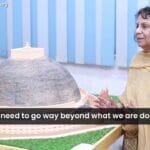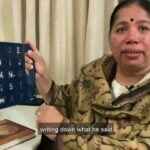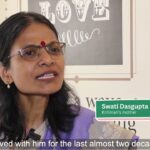Poonam Natarajan advocating Independent Living for Persons with Disabilities
In this film, Poonam Natarajan, Poonam akka to all, Founder of Vidya Sagar, speaks from the heart, offering insights into the realities that many parents of children with disabilities face.
This film offers a deep dive into the challenges and solutions related to independent living for people with intellectual and developmental disabilities in India. Poonam shares insights into the evolution of the National Trust Act and her journey in developing a comprehensive support system “BLISS” that empowers people with disabilities to make decisions about their lives.
Through this film, viewers will gain awareness of the critical need for inclusive environments and the significance of creating support systems that go beyond just the family, ensuring that every person can live a life of dignity and choice.
What was the objective of the National Trust Act?
So, the National Trust Act, which was enacted in 1999, uh was enacted because a whole lot of parents uh of basically from Parivar went to the government and said that the 95’ Act does not really full…uh really fulfill the needs of people with intellectual developmental disabilities.
It is an act of independent living actually, it’s about…the main question that it asks is, ‘what happens to my child when I’m no more?’
So how do we create support systems for children, um, for adults with intellectual developmental disabilities, and especially when the family size diminishes and the parents have grown old or they’re no more…what happens?
That’s the big thing.
So, in National Trust we had, among our registered organizations about 250 parents associations.
And every parents associations, different parts of the country, had one ambition and that was to create a uh kind of a small uh residential facility where their children will live once they’re no more and where other parents will look after all the children.
There was a program called ‘Samarth’ and then we set up a program called ‘Gharonda’ and the idea was to uh support organizations to set up these residentials.
The learnings from the West are, that we need to dismantle these institutions and the people from disabilities need to come out into the community.
So we’re talking about deinstitutionalization in the West and somewhere in our country we’re creating these mini institutions.
How was BLISS created and what are its four pillars?
Once I left National Trust, one of my dreams was to think of a solution, again which will…a solution to these little mini institutions that were coming up.
So, I actually did a needs assessment with about 110 families.
I came to VidyaSagar and I sat down and called some of…alumni…the…our students who passed out from here and parents and started talking to them about what their needs were.
And everybody wanted some safe place for their uh child once…they said I…if one of…one of us passes away, for both, the parent and the child…or for only the…um, so as they become older and things like that.
One of the things I found was the parents were overprotective and very difficult actually for parent…even the pa…the parent of the ch…person, the adult with disabilities, actually for them to separate also because they’ve lived together for 35-40 years, but there’s a big worry.
From that needs assessment um, we, a program was conceptualized which we called BLISS.
BLISS stands for Begin to Live Interdependently with Support Systems.
Now as it is conceptualized, what I realized was we really had to create a whole ecosystem.
And it kind of became nine different pillars.
So, BLISS has nine pillars and it’s really a work in progress.
I…look at it like an action-based research.
What we’re trying to do, some of it will work, some of it will not.
But the idea is that people with disabilities should have uh the decision to decide where they want to live.
And…do they want to live with their own families?
Maybe when the parents are no more, with their siblings?
Or do they want to live in the community, in a group home?
Or do they want to work somewhere and live in a working women’s hostel?
I…the choice should be there and around them we should be able to create the support systems they need.
So that is the premise we work with.
As I did the need…need assessment, many of the adults, though some of them had done vocational training, they somehow had lost their way and they needed to kind of anchor themselves again, to decide what do they want to do uh you know uh in the years to come.
And therefore we went with this uh, you know, PATH.
It’s a person, person centered planning program.
We got Keystone um to come over and train us because…to…how to make a path.
Path is Planning Alternatives for Tomorrow with Hope, that’s what it stands for.
So, what you really do is, you decide on what the dream the person has and you build a kind of a path leading up to.
You may not reach…
I mean, if the person’s dream is to reach the moon, you may not be able to get there, but leading up to what they would like to do and into more kind of…the…maybe into more, not very abstract but very very concrete plans.
What you would do in the next uh say 5 years.
So these five years…so then what would I do in the next two years?
In the next one year? In the next 6 months? In the next 3 months? In the next month? Tomorrow?
How should I start?
So that’s how the path builds up, right?
So that’s our first pillar.
When an adult comes and a family comes, we start with this to help them think of where what how and what do they want to live because most of them are just ? 5 mins
Families are…they haven’t thought of anything.
And adults may have been through schooling, but somehow they…and some of them know what their talents are, what they’re, you know, good at.
But many don’t, so they have to kind of still discover themselves.
So that’s the first one.
Then the other thing which I realized was that workforce for adults is lacking in our country.
We’ve somehow put all our energies into the six to…early intervention we’ve done, quite a bit but, six to eighteen…but after eighteen is very blur.
Now, the UN convention, UNCRPD talks about a personal attendant or uh but we just go ahead and say a caregiver and think it’s the parent.
So, even when they do caregiver’s training, they actually want to train parents.
But parents are going to grow old.
Parents have a lifelong commitment to their child, but it cannot be at the same intensity physically, emotionally.
Other peo…the person has to get on with other people.
You know, it could be friends, it could be siblings, it could be relatives but they have to find a life outside that of the sphere of the parents.
In National Trust we call them ‘Sahyogi’.
Because ‘Sahyogi’ is a person who supports you, a supporter.
We have already started the caregiver’s training program.
The Tamil Nadu government is certifying our course.
So, we’re, we’re still, we we we we find that the most important is workforce for people with disabilities.
There are no job coaches in India, so even when a person with intellectual disability gets a job, the big issue is, to sustain it they need support for a fairly long time, three to six months.
There are no uh uh independent travel trainers.
We want other professions also to be trained.
So, that was the second pillar.
The third pillar is, was, uh Reasonable accommodation.
Now, in, under reasonable accommodation, the first thing I found that a lot of students, especially people with cerebral palsy or multiple disabilities who are on wheelchairs, even in their own homes, their whole home was not accessible to them.
They couldn’t reach the kitchen.
If they could reach the kitchen, they couldn’t reach the washbasin.
If they wanted to cook, they couldn’t reach the gas.
Reasonable accommodation got divided into different parts and one was um uh TARA – Team for Accessible Reasonable Accomodation to make homes accessible or to make any space, offices, accessible.
And to, like, we’ve done the kitchen, the kitchen are accessible for people with disabilities.
Press is come down.
The person who not take like this no, yeah, it’s come down, we take the thing and put it again, it’s go up…go up.
Vegetable cutting, plate like this.
This fully wheelchair height, put vegetables (tarkari), sorry, potato, tomato, like that.
The person who not doing like this…yeah…we, this one is adapted tap and one, one finger we use, on and off.
One finger.
So, that the food does not come out, go outside.
Part of reasonable accommodation is three-four things: Accessible homes, Accessible transport, and also a kind of demonstration of all the assistive devices possible.
So, the accessible transport is a um…public transport is not accessible, so how do people with intellectual developmental disabilities actually reach their workplace?
And that is why many of them are not working or they start working and then they leave their jobs.
So we, um, we set up ‘Get Going’, which is a kind of a model of accessible transport with two vehicles which are used in the city of Chennai.
You know, anybody can hire them and lots of people are hiring them for their elderly parents.
For some of them are, for their children to go on uh to the hospital or to go for work or to go uh to go on a little holiday.
But it’s not enough.
It really needs to be upscaled a whole lot.
So, that is the, basically the reasonable accommodation.
Then, we had the Maintenance therapy.
Many of my students who had grown up and are now at home are that the private clinics where they went for therapy did not understand what is cerebral palsy and they were giving them therapy as if they would had a stroke.
So, it was, and so, you know, you get the…the person who’s never walked for 30 years is not going to walk.
But you say, ‘no no no, I’ll make you walk’ and they get so frustrated they stop going for therapy.
So, actually the uh we need to develop Maintenance therapy for long-term wheelchair users.
There is not enough knowledge about that in this country.
Because long-term wheelchair users is a lot of problem with their feet, with their knees, with their ankles, where they need constant, good therapy every day.
And that has not been emphasized by the therapists in India.
So, I’m talking about adults who maybe, you know, once you’re a…20, next and you’re on a wheelchair and for the next 40 years of your life or 50 years of your life, you’re going to live on a wheelchair.
What do you need to do to be uh, you know, to be really fit all the time and to be able to live your life fully?
Then we have the pillar, is called TED-SS: Trust Enabled Decision making with Support systems.
Now the problem is every parents says, wants to make a trust.
They have a little pot of money and they want to create a trust for their child.
That’s great.
You create the trust.
But in that trust we want to put one more thing, and that is called the Support Circle.
You see, the whole decision between supported decision making and substituted decision making is a whole question of guardianship and no guardianship.
So, people who want to go for the guardianship, well, the guardian will help you make, will make the decision for you.
That’s what the National Trust Act says.
But a lot of people don’t want a guardian, and they’re talking about supported decision making.
So you need a support circle.
Now when we started talking to parents about this trust and creating this support circle, and of course even in my needs assessment, we realized that they actually had not created any kind of friends, allies or people who will support their child after them.
And it’ll always, they would, even the person with disabilities will say, ‘it’s my mother who I go to for everything. Or my mother or father’ but it wasn’t a whole lot of people.
It was not like non-disabled people who, you know, we learn how to create our support systems, very naturally wherever we go.
We shift house, in the new place we create a support system.
But our children with disabilities have no support system.
So we have now started TED-SS after, you know, working with 32 families and realizing that we cannot do it uh, you know, trying to create this support circle through just uh uh, you know, encouragement, motivation, it’s not gonna happen.
So now we’re starting with actually our, in Vidya Sagar with our children, from early intervention.
And from reception class, when they join school, six year olds, what we’re telling families, that we need to work also in the neighborhood.
We need to do, first of all, a resource mapping of the neighborhood.
By resource mapping I mean all the places that the person, as she grows, would like to visit.
So, in the neighborhood it could be the next apartment building where she want, she wants to have friends or she…other people her own age.
It could be a little coffee shop.
It could be a little library.
It could be um any, anything else, it could be a Montessori school.
But to create a resor…what, where are the places this person would like to be?
And who are the people who will become part of this support circle?
Is over this…starting at 6 years or 5 years, going up to 18 years, can we create that support? It could be siblings, it could sibling’s friends.
It could be neighbors who become very close.
It could be cousins.
It could be anybody!
Or it could be pals which come out of the community.
You know, like one uh, in Delhi, there was a girl whose support system was the lady who ironed outside her house.
So, any, any time there was a problem or she was not well or she, once she never came out for 3 days and that lady went and told the neighbors that, “I don’t know what’s wrong, she hasn’t come out for 3 days”.
So, the neighbors then went to see what the problem was and she was not well and she lived alone with a single parent.
So, the support system can be anybody.
It could be the shop you go to eat your dosa.
It could be the person who serves you, who learned, learns to see how do you speak, how do you communicate and become your support person.
So, of course the support person on a long-term scale we have to figure out and work out but we start with the neighborhood, we start by creating this environment of inclusion, environment of uh uh, you know, creating a support circle.
So that is TED-SS.
So, these are the four-five pillars that we worked on till now.
What are your future focus areas?
The pillars we are hoping to work on is setting up group homes, which we call the Swayam, is uh, setting up, we have one pillar called Peer counselors, because I found that in Spinal Cord Injury Center, people who’ve had an accident and have lost their mobility, they do this three month course on peer counseling and they become excellent counselors for another person who’s had…
So I wanted to, I want to explore peer counseling.
So that’s one of my pillars.
And the last pillar, the most important, is the pillar called Leisure.
It all started with my son because I uh he, he had very high support needs.
He could neither be in academic stream, nor could he do a vocational training, because he was uh profoundly disabled.
We had a lot of uh students we took in who actually could not be part of the academic stream or the vocational stream, so we created…but they needed therapy.
They needed to have physiotherapy, speech therapy, they needed to have lot of activities which make life uh more joyful for them.
And as they grew older, we called the group, called The Adult Leisure Program.
And so these kids just about do what they want.
So they listen to music, they go out on a trip, they might…they love…some, some of them love, like my son, used to love to travel.
They go to the beach.
Or they might want to do some pottery, or some painting.
Or you want to just, or you know, some kind of…anything…Zumba.
So, it is a place where people with disabilities, because these, some of these uh resource are not easily available to them.
So, sports, a lot of people with disabilities want to do sports, you know, but it’s not accessible.
So, how can we make it accessible?
So, the leisure one is a big one and I’m hoping that we can create some facilities which become model for the rest of the country.
assisted living, BLISS support system, Breaking Barriers, community inclusion, developmental disabilities, dignity and choice, disability advocacy, disability awareness, disability rights, empowerment, inclusion, inclusive environments, independent living, intellectual disabilities, lifelong support, National Trust Act, parental challenges, policy and disability, Poonam Natarajan, self-determination, Social Change, special education, special needs support, support systems, Vidya Sagar
Dive Deeper: More on Disability
Learn about the most common inquiries surrounding disability, education, legislation, accessibility, employment and other sectors related to disability.


















